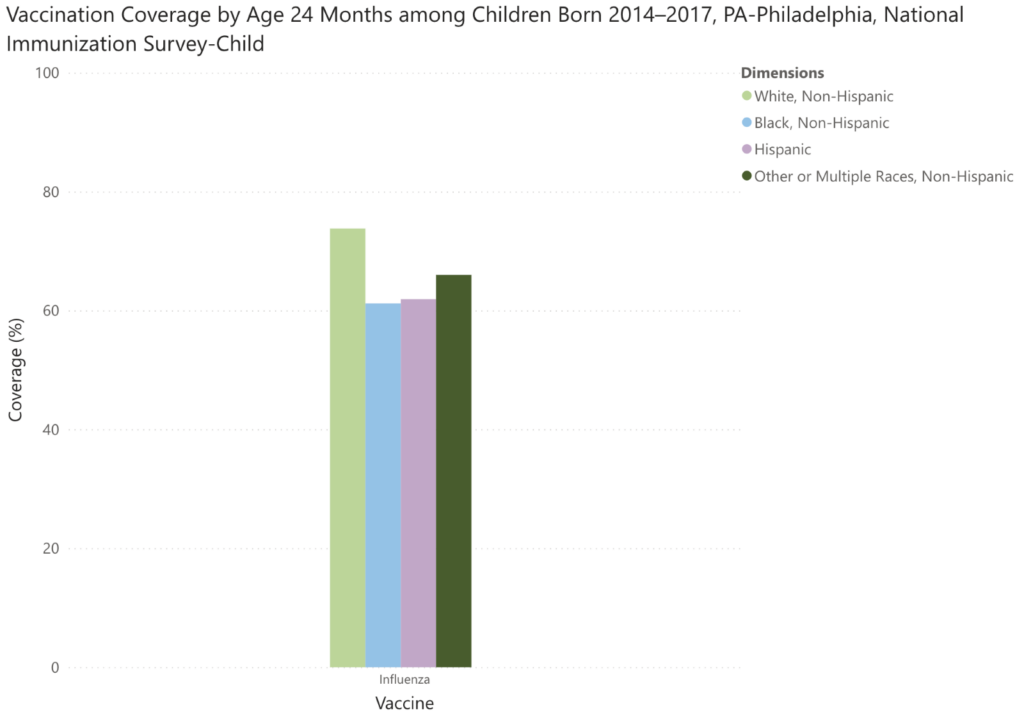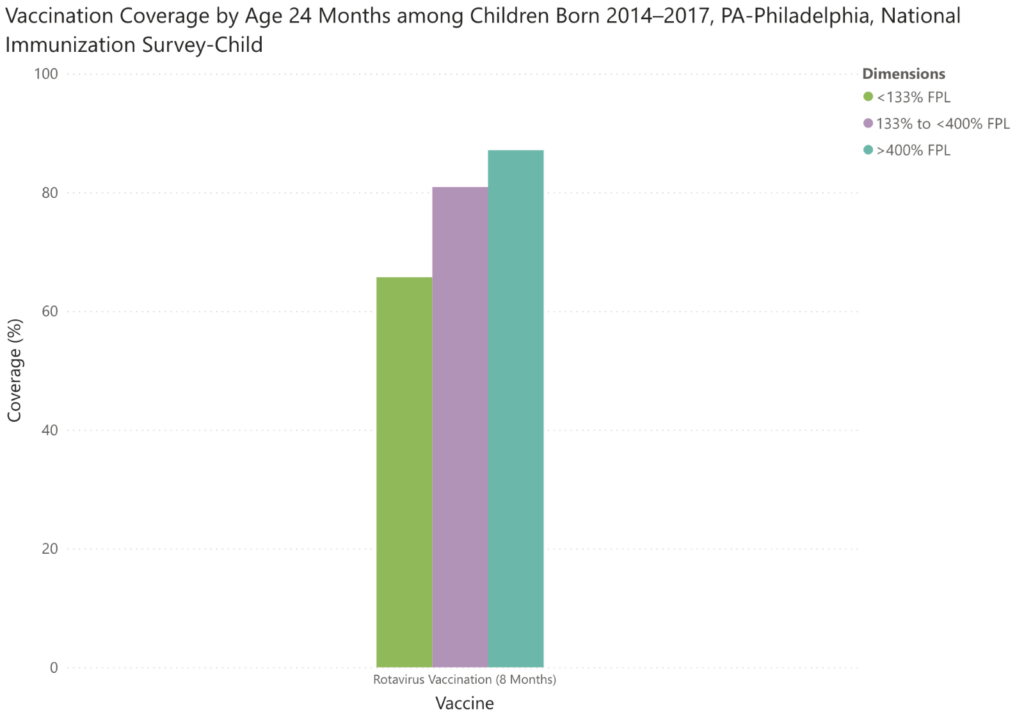Notices
J&J/Janssen COVID-19 Vaccine Expiration May 6, 2023
J&J/Janssen COVID-19 Vaccine Expiration May 6, 2023
- dispose of expired COVID-19 vaccine in accordance with local regulations and processes regulating medical waste, and
- report disposed as wastage in VTrckS
Protecting Infants from Vaccine Preventable Diseases
Protecting Infants from Vaccine Preventable Diseases
National Infant Immunizations Week is April 24 to April 30 this year, serving as a reminder to protect infants in Philadelphia from vaccine preventable diseases.
Over the years, immunization providers in the United States have reached major milestones in protecting infants through vaccines. Through immunization, we can now protect infants and children from 15 vaccine-preventable diseases before age 2.
Schedule and Updates
View the CDC immunization schedule for children and adolescents.
There are important updates to COVID-19 immunization recommendations for infants:
Previously unvaccinated: Children 6 months through 5 years of age who are unvaccinated may receive a two-dose series of the Moderna bivalent vaccine (6 months through 5 years of age) OR a three-dose series of the Pfizer-BioNTech bivalent vaccine (6 months through 4 years of age).
Previously vaccinated: Children 6 months through 4 years who previously completed their full two- or three-dose monovalent Moderna/Pfizer COVID-19 primary vaccination series are now recommended to receive a dose of Moderna/Pfizer’s updated (bivalent) COVID-19 vaccine.
Children 6 months through 5 years of age who have received one, two, or three doses of a monovalent COVID-19 vaccine should receive a bivalent vaccine, but the number of doses that they receive will depend on the vaccine and their vaccination history.
Healthy People 2030
Philadelphia immunization providers have made measurable progress in infant immunization coverage. However, immunization rates fell during the COVID-19 pandemic, and have not yet returned to pre-pandemic levels.
In Philadelphia, vaccination coverage with 4 doses of the DTaP vaccine in children between 0 and 2 years old was around 84% in 2021.
Healthy People 2030 objective IID-06 is: Increase the coverage level of 4 doses of the DTaP vaccine in children by age 2 years. The target for this objective is 90%.
Philadelphia providers have an opportunity to increase immunization coverage for this metric to reach or exceed the target by 2030.
Local Data
In addition to increasing DTaP vaccine coverage, Philadelphia providers can improve infant immunization coverage by focusing on addressing disparities.
Local data shows that influenza vaccination coverage among infants was lowest at 55.8% among the lowest income group in the data set, as compared with 84.3% among the highest income group in the set. In addition, influenza vaccination coverage was 61.2% among Black infants and 61.9% among Hispanic infants, as compared with 73.8% among white infants.

Rotavirus coverage was 65.7% among the lowest income group, as compared with 87.1% among the highest income group. Rotavirus coverage was 70.3% among Black infants and 69.8% among Hispanic infants, as compared with 84.1% among white infants.

Preexisting social determinants of health such as economic burden, lack of transportation, and lower rate of insurance coverage contribute to these disparities. However, immunization providers can use multiple strategies to close the gaps in vaccination coverage.
Strategies to increase vaccination rates among Black, Hispanic, and American Indian/Alaska Native communities include strongly recommending flu vaccination and making culturally appropriate vaccine recommendations (e.g. using materials with images representative of those in the community, addressing community-specific concerns and misinformation, and using the predominant language spoken in the community, such as Spanish).
Providers can also work toward increasing vaccination coverage among low-income populations by using evidence-based strategies such as immunization reminders, standing orders to provide vaccination whenever appropriate, and immunization information systems. Additionally, review immunization schedules with parents at the child’s first visit to show vaccines that are upcoming.
Resources
Improving communication between providers and patients is crucial to increasing immunization coverage among infants in your office.
Download and print coloring sheets for National Infant Immunizations Week.
Talk with parents and caregivers about their infant’s missing immunizations. Continue the conversation and offer educational resources for caregivers who are hesitant.
National Infant Immunization Week
National Infant Immunization Week
- Build a culture of immunization in your organization by fostering a culture of immunization.
- Learn simple tips for talking with parents about childhood vaccines.
- Share this parent-friendly vaccine schedule.
- View more resources from CDC.
- View the PDPH Vaccines for Children resources.
Print and Digital Immunization Resources
Print and Digital Immunization Resources
Pediatric Immunization Techniques Training
Pediatric Immunization Techniques Training
**Please arrive 15 minutes early. Late arrivals will not be able to attend.** The Immunization Program is hosting a FREE Pediatric Immunization Techniques training this spring. Class participants are limited and will be taken on a first-come, first-served basis. A maximum of 20 participants will be accepted. Participants can only attend one training per year.This half-day, interactive education session will focus on the basics of vaccine-preventable diseases, vaccine types, the Vaccines for Children (VFC) program and requirements, and pediatric immunization administration techniques.We encourage attendance by Nurses and Medical Assistants who administer vaccines or who will be administering vaccines to pediatric patients in the future. This course is beneficial to new practitioners as well as seasoned practitioners who need a refresher course or would like an update on best practices for administering vaccines.We hope to see you there!
Adolescent Immunization Action Week is Here!
Adolescent Immunization Action Week is Here!
April 3 to April 7, 2023
Novavax 10 Dose Vials Unavailable to Order After 4/5/2023
Novavax 10 Dose Vials Unavailable to Order After 4/5/2023
Increasing HPV Vaccine Uptake for All Ages
Increasing HPV Vaccine Uptake for All Ages
Increasing human papillomavirus (HPV) vaccination rates can be tricky, particularly due to the stigma associated with sexual behavior among adolescents. International HPV awareness day was March 4, and served as a reminder to continue local HPV vaccine promotion efforts.
Nationally, HPV is estimated to cause 36,000 new cases of cancer each year. We have an opportunity to eradicate HPV-associated cancers, and yet too many people are not getting a safe and effective vaccine that prevents six different cancers associated with HPV including oral pharyngeal and cervical cancer.
The HPV vaccine is approved for ages 9 years through 45 years. The American Cancer Society and American Academy of Pediatrics (AAP) recommend vaccination at age 9.
Are We Making Progress?
Healthy People 2030 vaccination objective IID-08 aims to increase the proportion of adolescents who receive recommended doses of the HPV vaccine. This objective is measured by tracking the proportion of adolescents aged 13–15 years receiving 2 or 3 doses of HPV vaccine.
The objective’s target is 80%, and the latest national data indicate that 54.5% of adolescents have received the recommended doses. This is a slight improvement from previous years, but there is still progress to be made to achieve the desired target.
Strategies for Increasing Vaccination Uptake
Receiving a health provider recommendation for the HPV vaccine is the most effective strategy for improving vaccination rates. However, barriers such as parental hesitancy (for adolescents), insufficient provider recommendation, and time constraints can inhibit HPV vaccine uptake.
Here are some tools and resources to boost HPV vaccine uptake in your practice:
Administrative processes:
- Set your electronic health record and pharmacy notifications for patients aged 9 years through 45 years. Starting at age 9 has been shown to increase vaccine completion by 22 times.
- Review your patients who have not completed their 2 or 3 dose series and proactively recall patients to complete the series. Check adult patients through age 45 to ensure they have started and completed their HPV series.
- If you are not able to stock vaccine at your facility, leverage your local pharmacy to administer vaccinations to patients.
- Implement standing orders for immunization in your practice.
- Identify an immunization champion at your facility – the person who will take the lead of your standing orders program.
Clinical encounters:
- Make a strong recommendation for HPV vaccines for all patients aged 9 years through 45 years. Data shows that your recommendation may improve vaccination rates by up to 5 times.
- For adults aged 26 years through 45 years, engage in shared decision making to help determine whether the patient will benefit from vaccination. A vaccination recommendation should be made in all healthcare settings to include acute, non-acute, GYN, dental, and pharmacy locations.
- Encourage same day vaccination in your facility.
This toolkit from the American Academy of Pediatrics (AAP) has patient-focused materials (social media graphics, videos, and articles) which can promote awareness of the HPV vaccine. Additionally, this AAP resource contains professional resources and printable PDFs to promote HPV vaccine education.
